Wednesday, June 2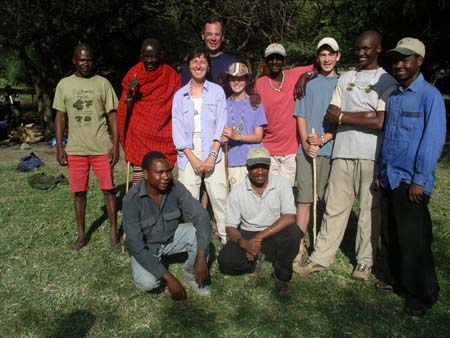
Paula: We heard the sunrise this morning well before we saw any light. It sounded as though thousands of birds suddenly awoke and felt compelled to greet the sun. Lake Natron is known for its abundant bird life and in addition to the flamingoes, we have seen many shore birds and other beautiful species of pelicans, horn bills, eagles and herons.
After packing our bags and having breakfast, it was time to say goodbye to Justin, the staff at our Lake Natron campsite, and some of the local Maasai who have been helping us camp and hike over the past four days. We have learned a great deal from them all and their warmth and friendliness will be something we will not forget. They especially loved seeing our pictures posted on the computer during the evenings and frequently gathered around Steve who would find himself presenting a slide show several times each night
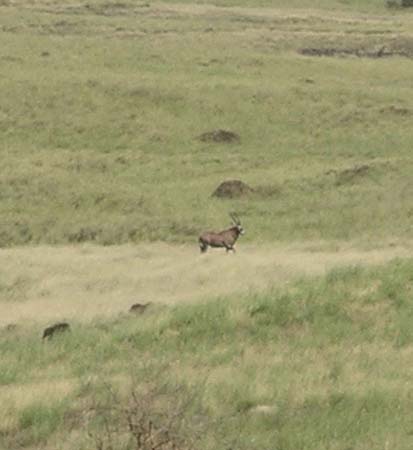 We
left Lake Natron heading south down the Rift Valley toward Lake Manyara. The
drive was very bumpy and Nassibu had to make detours into the bush several
times to avoid deep gullies in the road. We enjoyed watching for wildlife
along the way and in addition to seeing giraffe, zebra, ostrich and gazelle,
we saw our first group of oryx. This antelope is more difficult to spot and
Nassibu said he had not seen one in over five years. The black and white markings
on this antelope's face and its towering thin horns make it particularly memorable.
We
left Lake Natron heading south down the Rift Valley toward Lake Manyara. The
drive was very bumpy and Nassibu had to make detours into the bush several
times to avoid deep gullies in the road. We enjoyed watching for wildlife
along the way and in addition to seeing giraffe, zebra, ostrich and gazelle,
we saw our first group of oryx. This antelope is more difficult to spot and
Nassibu said he had not seen one in over five years. The black and white markings
on this antelope's face and its towering thin horns make it particularly memorable.
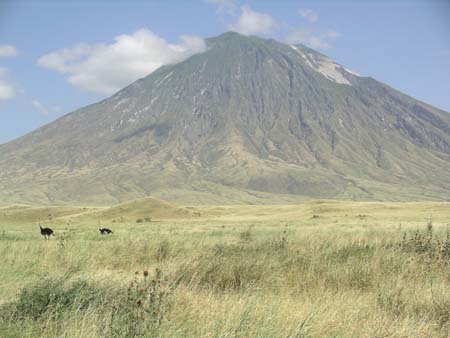
We reached the E'Unoto Retreat in time for lunch. There are no signs on the road and Nassibu actually used his binoculars to locate the lodge and determine where to make the appropriate turn! We laughed about this but are actually getting used to unpaved and unmarked roads. We are certain that we have driven on more unpaved roads than paved since leaving home in January.
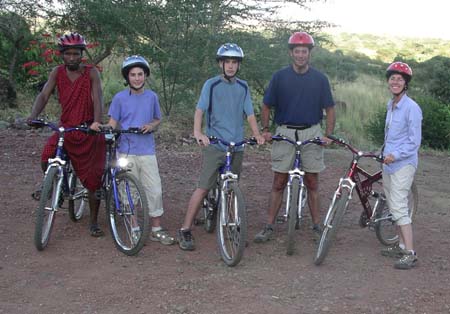 E'Unoto
is located on the hillside overlooking a lake where 20 hippos reside. We listened
to the sounds of monkeys, baboons and birds throughout the day as the surrounding
Maasi villagers constantly chased them out of their gardens. The Maasi that
live in this area are heavily involved with agriculture, and while bike riding
later in the afternoon we saw rice, corn, bananas and vegetables growing near
the lake. The Maasi guide who accompanied us on the ride explained that they
have to watch the fields day and night to keep out the wild animals. The hippos
try to graze in the fields at night and this has been a problem
E'Unoto
is located on the hillside overlooking a lake where 20 hippos reside. We listened
to the sounds of monkeys, baboons and birds throughout the day as the surrounding
Maasi villagers constantly chased them out of their gardens. The Maasi that
live in this area are heavily involved with agriculture, and while bike riding
later in the afternoon we saw rice, corn, bananas and vegetables growing near
the lake. The Maasi guide who accompanied us on the ride explained that they
have to watch the fields day and night to keep out the wild animals. The hippos
try to graze in the fields at night and this has been a problem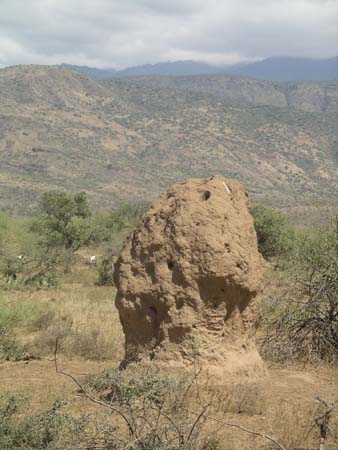 .
.
The Maasi around E'Unoto allowed the lodge to be built on their land and in return the American owner agreed to build them a school, a dispensary for medicine and to help them maintain a permanent water supply. In addition, the lodge is staffed by local Maasi people and 10% of the lodge profits go directly to the village. Along with agriculture, this makes it possible for the people of these villages to reside here permanently. While they still raise cattle, these other sources of income allow them to build larger homes and have some additional possessions. We even saw some homes with chimneys coming out of the thatched roofs.
The Maasi here view the Maasi around Lake Natron as primitive and can't understand why they don't become more heavily involved with agriculture. Not surprisingly, the Maasi we met at Lake Natron shun those tribes who are making such major changes, stating that they are abandoning the traditional life.
After our bike ride and a nice dinner, we settled into large beds surrounded by mosquito nets. Tomorrow we will be visiting a nearby settlement, Mto Wa Mbu, where people from a variety of different tribes have decided to establish a farming community. This will give us an opportunity to meet and learn about some of the other tribes in Tanzania before we head to Gibbs Farm near the Ngorongoro Highlands.
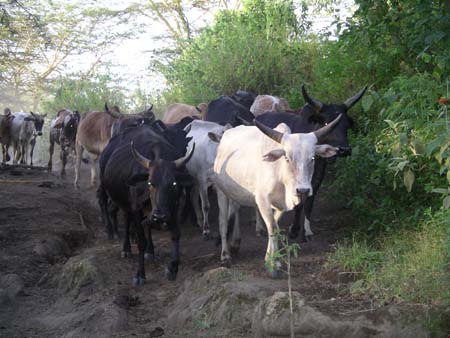 Katie's
Kwick Kwacks: The Importance of Cattle in Maasai Culture. Over the
past several days, we have learned a lot about the role of cattle in Maasai
life. As we visit villages and talk to the people here, the importance of
these animals becomes increasingly clear. The following paragraphs discuss
some of the ways these cattle are important, and what they mean to the Maasai
people.
Katie's
Kwick Kwacks: The Importance of Cattle in Maasai Culture. Over the
past several days, we have learned a lot about the role of cattle in Maasai
life. As we visit villages and talk to the people here, the importance of
these animals becomes increasingly clear. The following paragraphs discuss
some of the ways these cattle are important, and what they mean to the Maasai
people.
For hundreds of years in Maasai history, cattle have remained the most dominant part of the people's lives. The people begin to raise this live stock at as young as 5-7 years old. They spend most of their day with these animals - part of the time watching them graze and herding them, and part of the time milking. Every Maasai boy upholds these duties. Although the people rarely eat their prized cows, a large portion of their diet comes from these animals. The Maasai drink the milk and even the cow's blood in times of need. The meat source of their diet comes from the goats and sheep that they raise. Although Maasai do not traditionally practice agriculture, some are beginning to make this a part of their diet. Besides food, the Maasai use their cows' dung and urine for building their homes.
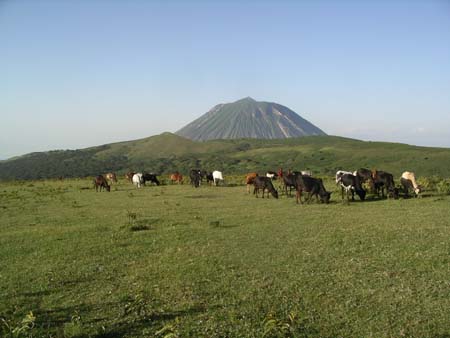 Although
cattle are important to the tribe for their sources, these creatures mean
more to the people than just food and shelter. Cattle are their means of currency,
status and wealth. The Maasai people believe that all of the cattle in this
world belong to them. These animals are the only kind of wealth they know
and understand. In the tribes eyes, the more cattle you have the more respected
you are in society. While walking in villages the people often ask our Maasai
guide, "Who is taking care of the tourists' cattle while they're in Tanzania"?
When our guide tells them we have no cattle they say, "Well, that's too
bad - they must be poor." This is something very new for us and really
shows how important cattle are in their society.
Although
cattle are important to the tribe for their sources, these creatures mean
more to the people than just food and shelter. Cattle are their means of currency,
status and wealth. The Maasai people believe that all of the cattle in this
world belong to them. These animals are the only kind of wealth they know
and understand. In the tribes eyes, the more cattle you have the more respected
you are in society. While walking in villages the people often ask our Maasai
guide, "Who is taking care of the tourists' cattle while they're in Tanzania"?
When our guide tells them we have no cattle they say, "Well, that's too
bad - they must be poor." This is something very new for us and really
shows how important cattle are in their society.
Most of the trading and payments are also done with cattle. Some examples of this are the dowry for a man when he is getting married and the payment for crimes etc. Cattle are signs of wealth and respect - if you become rich for some reason you use it to buy more cows and gain a higher status. The animals are so respected that when the herders go to the streams, they allow the cattle to drink before the person can use the water. The cattle mean everything to the Maasai people.
All in all, cattle are a very important part of everyday Maasai life. The people use these to define all aspects of their society, including status and respect. It has been interesting to learn about the culture of these people, and I'm looking forward to seeing more tribes as we continue our journey through Tanzania.
Animals seen today:
Zebra
Grants Gazelle
Oryx
Ostrich
Giraffe
Wildebeest
Thomson Gazelle
New birds seen today:
Pale Chanting Goshalk
Secretary Bird
